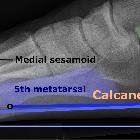Talometatarsale-I-Winkel

Weight-bearing
lateral projectional X-ray of a normal foot of a 31 year old male, showing measurement of the talar-1st metatarsal angle, also known as Meary"s angle. It is the angle between the the long axis of the talus and first metatarsal. It is important for diagnosing and grading pes cavus and pes planus. Reference: Pes Planus. University of Washington, Department of Radiology. Last modified: 2016/08/14

Open triple
fusion versus TNC arthrodesis in the treatment of Mueller-Weiss disease. Lateral weightbearing radiograph showing severe sclerosis of the navicular and representation of stage 4 according to the Maceira classification. Angle A denotes the Meary-Tomeno’s angle

Meary's
angle • Meary's angle - Ganzer Fall bei Radiopaedia
Meary's angle or talus-first metatarsal angle has been used to identify the apex of deformity in patients with pes cavus and pes planus on lateral weight-bearing foot radiographs.
Measurement
It is the angle between a line drawn from the centers of longitudinal axes of the talus and the first metatarsal.
Interpretation
In the normal weight-bearing foot, the midline axis of the talus is in line with the midline axis of the first metatarsal. Normally Meary's angle is 0º, with abnormal values considered :
- angle >4ºconvex upward: pes cavus
- angle >4ºconvex downward: pes planus
It can also be used to classify the severity of deformity :
- mild <15º
- moderate: 15-30º
- severe: >30º
Siehe auch:

 Assoziationen und Differentialdiagnosen zu Talometatarsale-I-Winkel:
Assoziationen und Differentialdiagnosen zu Talometatarsale-I-Winkel:


